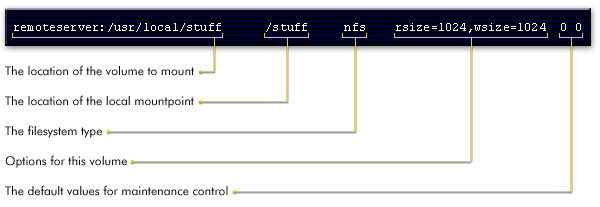Individual Components of etc/fstab
Elements from /etc/fstab
In this page matches parts of a
/etc/fstab file to the functions they perform.

remoteserver:/usr/local/stuff /stuff nfs rsize=1024, wsize-2014 0 0fstab image results
Caution: Do not forget when a remote shell or file editor is open on your desktop. Sometimes people forget that a window is remote and will edit some important configuration file on the remote system by mistake (such as the /etc/fstab file). You could damage the remote system with this type of mistake.
The fstab (or file systems table) file is a system configuration file commonly found at
The fstab file is read by the mount command, which happens automatically at boot time to determine the overall file system structure, and thereafter when a user executes the mount command to modify that structure. It is the duty of the system administrator to properly create and maintain the fstab file.
While fstab is still used for basic system configuration, for other uses it has been superseded by automatic mounting mechanisms.
The file has other names on some versions of Unix; for example, it is found at
/etc/fstabon Unix and Unix-like computer systems. Linux The fstab is part of the util-linux package in Linux. The fstab file typically lists all available disk partitions and other types of file systems and data sources that are not necessarily disk-based, and indicates how they are to be initialized or otherwise integrated into the larger file system structure.
The fstab file is read by the mount command, which happens automatically at boot time to determine the overall file system structure, and thereafter when a user executes the mount command to modify that structure. It is the duty of the system administrator to properly create and maintain the fstab file.
While fstab is still used for basic system configuration, for other uses it has been superseded by automatic mounting mechanisms.
The file has other names on some versions of Unix; for example, it is found at
/etc/vfstabon Solaris systems.